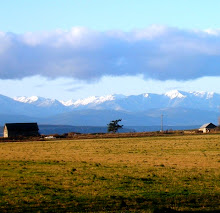Volunteers needed for 3rd annual Ebey's Reserve Community Barn Raising Project at the Boyer Barn
The Trust Board's 2010 Preservation Field School will focus on completing the protection of one of the Reserve's oldest barns--the Boyer Barn on Crockett Prairie, circa 1860. The Trust Board, National Park Service, Coupeville Lions and volunteer crew members will complete the restoration of the barn's cedar shake roof using historic techniques, which began in 2009. The Preservation Field School is scheduled to run four weeks, July 19-August 12th.
Field School participants will experience, first hand, what it was like for pioneers to build barns--before electricity, heavy machinery, or modern convenience. This is an opportunity to split cedar shakes with mallets, pound nails, work aside friends, and experience the satisfaction of helping retain an invaluable historic resource for another 150 years.
"The preservation field school introduces a new kind of community barn raising," said Mark Preiss, Reserve Manager, "instead of community coming together to build a new barn, the community is coming together to restore one of its heritage buildings--as well as learning and applying the preservation trade."
"Restoring old buildings is a real pleasure," adds Ron Boyer, Coupeville Lions member. "We learn techniques and methods on how to preserve old buildings, actually restore a valuable barn, enjoy the company of other volunteers and appreciate the work that is accomplished."
The Trust Board seeks volunteers to complete the project. Volunteers with any range of experience are welcome, especially individuals with a background in carpentry and construction. The four-week Field School will run Monday through Thursday from July 19 to August 12, 8 AM to 5 PM.
Sign up to participate as a member of the crew today! Volunteers are welcome for one day, or for all. Shifts are 8am-Noon and 1-5pm. Pre-registration is required; sign up at 360-678-6084, emi_gunn@partner.nps.gov.
Program Background
The Reserve's field school was established in 2008 to provide technical support to the owners of the Reserve's historic buildings, and to gove community members a hand-on opportunity to help preserve nationally significant buildings for future generations.
National Park Service Preservationist, Jason Benson will manage the project and oversee the crew of volunteers. All work will be consistent with the Secretary of the Interior's Standards for the Treatment of Historic Properties.
Benson attributes previous restoration project success to volunteer engagement. "The sheer enthusiasm and energy the volunteers bring makes the job easy," Benson said, "It is inspriing to witness people obtaining a new set of skills at all ages and finding meaningful ways to give back to their community."
In 2009, the field school completed half of the Boyer Barn roof, in addition to priority stabilization. In 2008, the Preservation Crew members reconstructed the roof of the Alexander Blockhouse, owned by the Island County Historical Society.
Boyer Barn
"The Boyer Barn's structure is very unique with large interior beams hewn, or split, by and, and fitted together with wooden joints," said local historic building expert, Harrison Goodall. "And the interior structure is in very good condition, considering its age of over 150 years, which makes it an especially important barn to preserve."
Goodall has evaluated the Boyer Barn and prepared the Stabilization Plan for the project. The Boyer Barn, circa 1860, retains a significant portion of its integrity as both the exterior and interior has changed little from its construction date. Its historical significance is tied to its form, shape, and scale including a textured shingle roof, vertical rough-sawn siding, hewn timber frame, mortise and tendon joinery, and original setting within the building complex and surrounding fields. The nature and quality of the craftsmanship, construction details, and evidence of specific tools that were used are especially unique.
The Boyer Barn is one of over 400 contributing historic structures within Ebey's Landing National Historical Reserve, most of which are privately held. By establishing a preservation field school, property owners and community are given tools to protect national treasures for future generations. The 2010 Ebey's Reserve Preservation Field School is a partnership between the Trust Board of Ebey's Landing, National Park Service, the Coupeville Lions Club, Freeman Boyer, and volunteers.




















